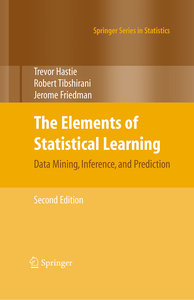KlappentextDuring the past decade there has been an explosion in computation and information technology. With it have come vast amounts of data in a variety of fields such as medicine, biology, finance, and marketing. The challenge of understanding these data has led to the development of new tools in the field of statistics, and spawned new areas such as data mining, machine learning, and bioinformatics. Many of these tools have common underpinnings but are often expressed with different terminology. This book describes the important ideas in these areas in a common conceptual framework. While the approach is statistical, the emphasis is on concepts rather than mathematics. Many examples are given, with a liberal use of color graphics. It is a valuable resource for statisticians and anyone interested in data mining in science or industry. The book's coverage is broad, from supervised learning (prediction) to unsupervised learning. The many topics include neural networks, support vector machines, classification trees and boosting---the first comprehensive treatment of this topic in any book.
This major new edition features many topics not covered in the original, including graphical models, random forests, ensemble methods, least angle regression and path algorithms for the lasso, non-negative matrix factorization, and spectral clustering. There is also a chapter on methods for ``wide'' data (p bigger than n), including multiple testing and false discovery rates.
Trevor Hastie, Robert Tibshirani, and Jerome Friedman are professors of statistics at Stanford University. They are prominent researchers in this area: Hastie and Tibshirani developed generalized additive models and wrote a popular book of that title. Hastie co-developed much of the statistical modeling software and environment in R/S-PLUS and invented principal curves and surfaces. Tibshirani proposed the lasso and is co-author of the very successful An Introduction to theBootstrap. Friedman is the co-inventor of many data-mining tools including CART, MARS, projection pursuit and gradient boosting.
ZusatztextFrom the reviews:
"Like the first edition, the current one is a welcome edition to researchers and academicians equallyâ¦. Almost all of the chapters are revised.⦠The Material is nicely reorganized and repackaged, with the general layout being the same as that of the first edition.⦠If you bought the first edition, I suggest that you buy the second editon for maximum effect, and if you haven t, then I still strongly recommend you have this book at your desk. Is it a good investment, statistically speaking!" (Book Review Editor, Technometrics, August 2009, VOL. 51, NO. 3)
From the reviews of the second edition:
"This second edition pays tribute to the many developments in recent years in this field, and new material was added to several existing chapters as well as four new chapters ⦠were included. ⦠These additions make this book worthwhile to obtain ⦠. In general this is a well written book which gives a good overview on statistical learning and can be recommended to everyone interested in this field. The book is so comprehensive that it offers material for several courses." (Klaus Nordhausen, International Statistical Review, Vol. 77 (3), 2009)
The second edition ⦠features about 200 pages of substantial new additions in the form of four new chapters, as well as various complements to existing chapters. ⦠the book may also be of interest to a theoretically inclined reader looking for an entry point to the area and wanting to get an initial understanding of which mathematical issues are relevant in relation to practice. ⦠this is a welcome update to an already fine book, which will surely reinforce its status as a reference. (Gilles Blanchard, Mathematical Reviews, Issue 2012 d)
The book would be ideal for statistics graduate students ⦠. This book really is the standard in the field, referenced in most papers and books on the subject, and it is easy to see why. The book is very well written, with informative graphics on almost every other page. It looks great and inviting. You can flip the book open to any page, read a sentence or two and be hooked for the next hour or so. (Peter Rabinovitch, The Mathematical Association of America, May, 2012)
ZusammenfassungThis book describes the important ideas in a variety of fields such as medicine, biology, finance, and marketing in a common conceptual framework. While the approach is statistical, the emphasis is on concepts rather than mathematics. Many examples are given, with a liberal use of colour graphics. It is a valuable resource for statisticians and anyone interested in data mining in science or industry. The book's coverage is broad, from supervised learning (prediction) to unsupervised learning. The many topics include neural networks, support vector machines, classification trees and boosting---the first comprehensive treatment of this topic in any book.
This major new edition features many topics not covered in the original, including graphical models, random forests, ensemble methods, least angle regression & path algorithms for the lasso, non-negative matrix factorisation, and spectral clustering. There is also a chapter on methods for "wide'' data (p bigger than n), including multiple testing and false discovery rates.


